#Sun Yuan
Explore tagged Tumblr posts
Text
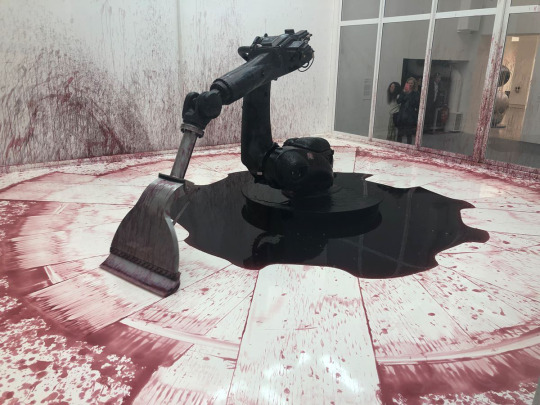
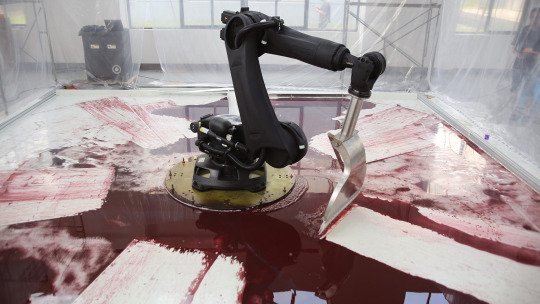
Sun Yuan & Peng Yu: Can’t Help Myself (2016)
7K notes
·
View notes
Text
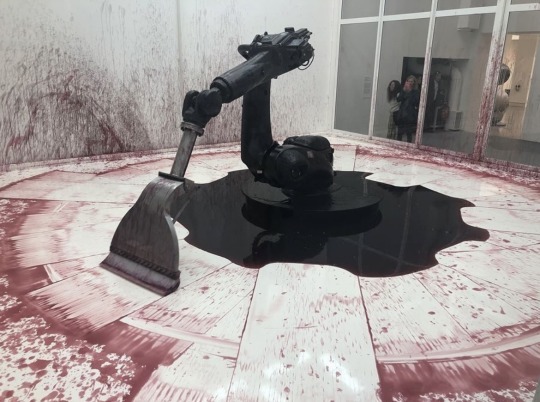
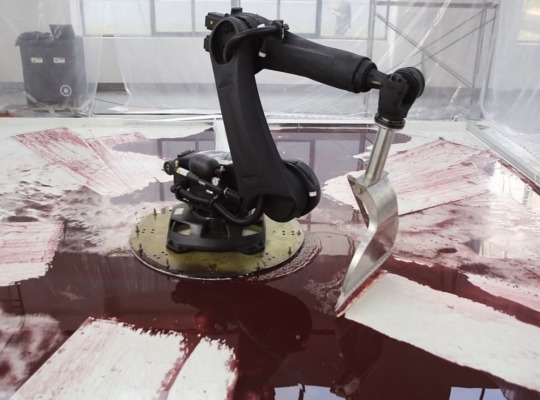

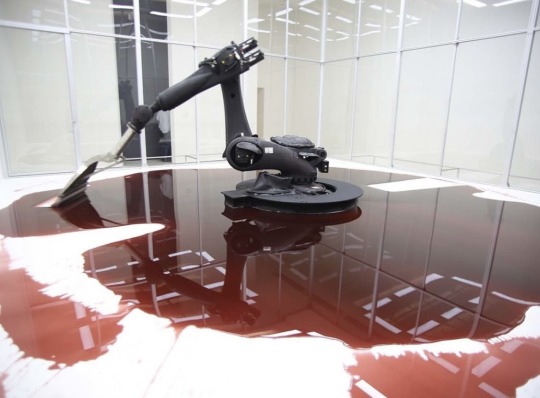
Sun Yuan & Peng Yu: Can't Help Myself (2016)
#sun yuan#peng yu#blood#bloody#bloodcore#gorecore#art#art exhibition#japan#tech#technology#museum#aesthetic#horrorcore#weirdcore#lovecore#sculpture#techcore#machina
513 notes
·
View notes
Text

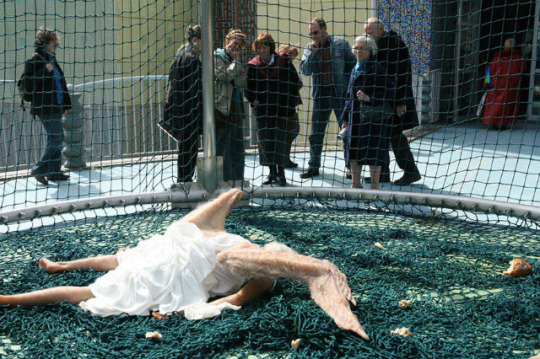
“The angel, a transcendent being, has become powerless, unable to carry out God's will, or to help those who believe in its existence.” — Sun Yuan and Peng Yu
Sun Yuan and Peng Yu Angel 2008 Silica Gel, Fiberglass, Stainless Steel, Woven Mesh 180 × 220 cm
#dND Studio Art of the Day#Art#Sun Yuan#Peng Yu#art#chinese#ประติมากรรม#Angel#conceptual art#God#artist#art quotes#painting#drawing#sculpture#sculptures#sculptor#sculpture art#figurative art#contemporary sculpture#anatomy#figure drawing#metal sculpture#contemporary painting#contemporary art#sculpture artist#ศิลปิน#ศิลปะ#inspiration#art of the day
657 notes
·
View notes
Note
What are your thoughts on Can’t Help Myself by Sun Yuan and Peng Yu? AKA the robotic arm sweeping up something bloodlike leaking out of it.

[Also requested by @archvillain]
First, I would like to highly recommend watching a video of this robot, it's cool as hell, and the movements really sell it, honestly.
So, I want to start with acknowledging the actual meaning of this piece. It's about the violence and Sisyphean nature of guarding and enforcing borders. "Every border implies the violence of its maintenance" and all of that. This is a very important political message. However, I think allowing yourself to only see an art for the intended meaning is counterproductive to the very nature of art.
The robot moves in a jerky fashion, tries desperately to keep this blood-like substance close to it. In doing so, it slowly destroys itself. It gunks up it's own mechanisms, it works itself to death.
And yet, this is all it can do. It was made to do this eternally. It lacks free will, it cannot do anything else and it cannot desire to do anything else. It quite literally, cannot help itself.
I find the jerky movements alluring, the inhuman nature of it, the constant reminder that it is far from human. I find the lack of control it has erotic. As I've said before, both extreme control and extreme loss of control are erotic, in my opinion.
The blood-like substance it seeks to contain and the voyeuristic nature of the viewer just elevate this. We are watching something, and should we be watching it? The desperation of the robot, the way it almost seems to be cleaning up its own blood, these feel intimate, like something not intended for us.
Overall, I give this one a 10/10. It elicits a strong "i think i hauve covid" from me.
176 notes
·
View notes
Text
Saw someone compare the Can’t Help Myself robot to Vessel from Sleep Token

Can’t Help Myself by Sun Yuan & Peng Yu
122 notes
·
View notes
Text
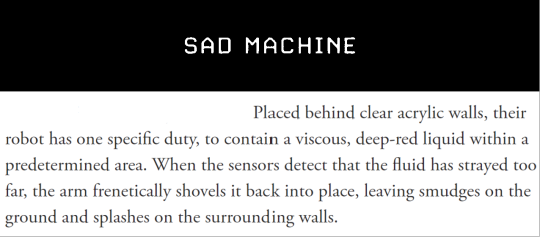


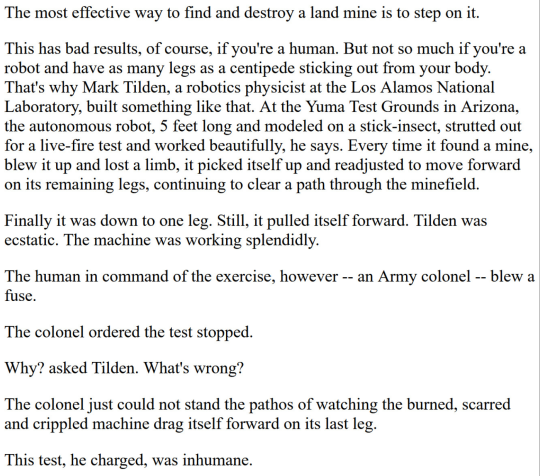




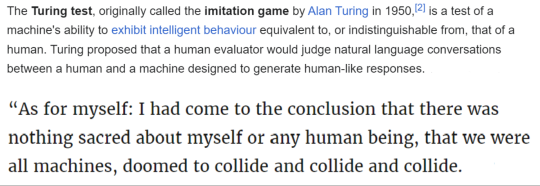
machines are human, too.
porter robinson, sad machine || sun yuan and peng yu, can't help myself || boston dynamics || the washington post || new york post || boston dynamics || tumblr || phillip k dick, do androids dream of electric sheep? || plainsight || wikipedia, turing test || kurt vonnegut, breakfast of champions
#web weaving#my weavings#on life#on humanity#the human condition#on robots#robots#sad machine#porter robinson#sun yuan#peng yu#can't help myself#boston dynamics#phillip k dick#do androids dream of electric sheep#plainsight#turing test#alan turing#kurt vonnegut#breakfast of champions
308 notes
·
View notes
Text
youtube
#robot#robots#ai#artificial intelligence#art#bleeding robot#robotic art#concept#conceptual art#sun yuan#peng yu#2016#can't help myself#Youtube
7 notes
·
View notes
Text
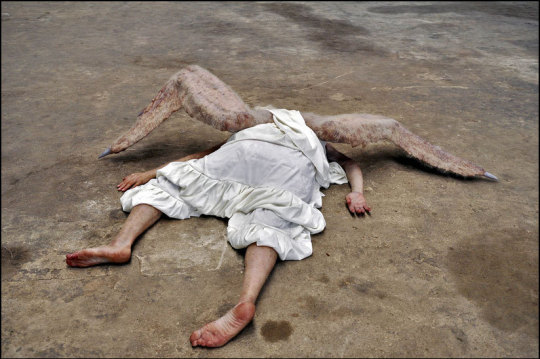
Look in art: Sun Yuan & Peng Yu
Sun Yuan [born 1972] and Peng Yu [born 1974] are artists living and working collaboratively in Beijing.
* * * *
Billy Collins, “The Afterlife” →
They’re moving off in all imaginable directions,
each according to his own private belief, and this is the secret that silent Lazarus would not reveal: that everyone is right, as it turns out. you go to the place you always thought you would go, the place you kept lit in an alcove in your head. Some are being shot into a funnel of flashing colors into a zone of light, white as a January sun. Others are standing naked before a forbidding judge who sits with a golden ladder on one side, a coal chute on the other. Some have already joined the celestial choir and are singing as if they have been doing this forever, while the less inventive find themselves stuck in a big air conditioned room full of food and chorus girls. Some are approaching the apartment of the female God, a woman in her forties with short wiry hair and glasses hanging from her neck by a string. With one eye she regards the dead through a hole in her door. There are those who are squeezing into the bodies of animals—eagles and leopards—and one trying on the skin of a monkey like a tight suit, ready to begin another life in a more simple key, while others float off into some benign vagueness, little units of energy heading for the ultimate elsewhere. There are even a few classicists being led to an underworld by a mythological creature with a beard and hooves. He will bring them to the mouth of the furious cave guarded over by Edith Hamilton and her three-headed dog. The rest just lie on their backs in their coffins wishing they could return so they could learn Italian or see the pyramids, or play some golf in a light rain. They wish they could wake in the morning like you and stand at a window examining the winter trees, every branch traced with the ghost writing of snow.
17 notes
·
View notes
Text

17 notes
·
View notes
Text




If I Died - Sun Yuan & Peng Yu
10 notes
·
View notes
Text




if i died , 2013
peng yu & sun yuan, silica gel and fibreglass
#i was looking into them after seeing the angel sculpture and i think this piece is my favourite#peng yu#sun yuan#death#🖌️
21 notes
·
View notes
Text




Sun Yuan and Peng Yu, Can’t Help Myself
700 x 700 x 500 cm, Industrial robot, stainless steel and rubber, cellulose ether in colored water, lighting grid with visual-recognition sensors, acrylic wall with aluminum frame
2016 Tales of Our Time, Guggenheim, New York, America
source
21 notes
·
View notes
Text

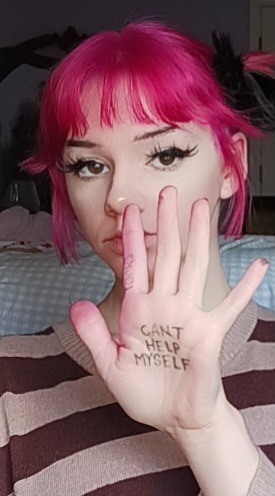
did a stick a poke on my palm the other night. messy, but I'm happy with the results :) . I love you can't help myself robot </3
#stick and ink#stick and poke#tattoos#palm tattoo#sun yuan#peng u#cant help myself#cant help myself robot#ok to reblog/like
16 notes
·
View notes
Text

Sun Yuan & Peng Yu
“Can’t help myself”
3 notes
·
View notes
Text

[Image ID: a young woman futilely tries to dry a runway with a cloth in the pouring rain. The video caption reads, “pov you’re doing your first fashion internship.” The top comment reads, “She’s that robot trying to clean up its own blood,” a reference to this art installation in the Guggenheim.]
#this killed me#can’t help myself#art#fashion#insta reels#pov#image ID#image described#guggenheim#meme#sun yuan#peng yu
3 notes
·
View notes
Text
The Dissection of Teenager Teenager by Sun Yuan and Peng Yu: Experience versus Innocence
EJS, UNLV
UNDER SUPERVISION OF DR DAVID GRUBER
2022
Abstract Popular American media controls the narrative of how we age. When we are young, we are curious, free and impartial to the reality of the world. And as we grow older, we are illustrated as static, subservient and somber. This essay identifies the following methods to explain the physical and emotional interspace between the elderly and the youth: the vernacular method and metaphor criticism. By utilizing these two methods, we can digest why the distance exists, and why it is crucial for our society to move past these dated ideals. First, with the vernacular method, we will understand the common interpretation of the elderly and the youth. With a foundational understanding of what it means to be an experienced elder versus an innocent youth, this essay outlines the metaphoric implications of a ‘stone head’ and a ‘boxed child’. Further, this study analyzes why Sun Yuan and Peng Yu’s Teenager Teenager is a social commentary of how society categorizes separation, communication, power and culture. We will discuss the greater implications of Teenager Teenager and its role in our community. Finally, this essay will reveal how we evolve from a dilapidated perspective of how we treat our elderly and our youth. Introduction
We face our parents across the dining room table. We see ourselves in their eyes, and they see themselves in ours. In American society, it’s essential for our wide-eyed wonder to stay within our youth. Before our pre-frontal cortexes were able to form, we were expected to choose our political parties and vote for a presidential candidate, decide whether we’ll be shuffled into college or lose ourselves in an endless cycle of part-time jobs after high school, and on top of that, we shouldered the burden of being an adult at the age of eighteen. And as we evolve, society expects us to neglect our naivety and welcome worldly responsibilities. There is a physical and emotional distance between our younger selves and the version we will become. In the following paper, I argue that Teenager Teenager by Sun Yuan and Peng Yu connect the differing values between the elderly and the youth. I find that the meaning behind Teenager Teenager is to showcase the youth’s bountiful curiosity while the elderly are depicted as observant, dormant ‘stone heads’. There is a clear dissonance between innocence and experience in these phases of life, and the brittle connection that bridges them is in dire need of re-ignition. I will analyze two rhetorical methods to expand the disconnect between these two age groups. Respectively, I will use the vernacular method to build a foundational understanding of the concept of innocence and experience, and then I will utilize metaphor criticism to grasp the bigger picture. This study will highlight how we can encourage the reconnection between the youth and elderly; it will also reveal what this implies for our society.
Methods
Before we begin our analysis, we must understand the two presented rhetorical methods. Vernacular method A vernacular is not a tangible thing. Instead, it is the reaction, the response and the language of a community. Cara Finnegan, the mind who developed “Image Vernaculars” writes that we’re inclined to understand another individual when we use our own “vernaculars” to make sense of an image (Finnegan, 2008). She emphasizes that vernaculars are the “tacit topoi of argument” and that it’s crucial that we’re aware our social competency to grasp our own vernacular and our peers. Finnegan wants us to be creative in our interpretations, as there is no wrong way to interpret a piece. The vernacular method is a way that helps us assess and decide the function of an image. It helps us uncover the imbedded layers of a piece. When an author uses the vernacular method, there are four steps. The author first reviews a situation, then they explore what others say about their situation; they make common interpretations. Then they add their own comment, they compare and contrast and choose the best interpretation.
Metaphor criticism Metaphors are also not tangible, but we use them in our every day life. A metaphor is a type of figurative language that allows us to say exactly what we mean, without truly saying it. A common metaphor is, “You have a heart of gold”. A heart of gold is not realistic, but we connect this phrase to someone who is genuine and kind. These types of metaphors are called dead metaphors; we use them so often the meaning is engraved to our mind. However, when we dissect complicated metaphors, we can separate the metaphor as the vehicle and the tenor. The vehicle is the description, and the tenor is what is described. The key to an impenetrable metaphor is to create ground; we want our audience to have enough knowledge so they’re able to make their own assumptions. Without ground, we would be comparing a thumb tack to a small nail. Similarly, a metaphor needs tension. If there is too much tension, the audience cannot make a connection. They would compare a thumb tack to an axe: these two items have no correlation. In order to dissect a metaphor, we identify the vehicles and the tenor. Then we unpack the ground, and the tension. Finally, we explain how the metaphor acts rhetorically and if this metaphor aligns with our interpretation.
Analysis Vernacular method In Teenager Teenager by Sun Yuan and Peng Yu, we observe a gathering in a familial living room. The adults sit next to one another on the couch, all within reasonable distance from one another. Instead of their regular human heads, they are replaced with stones. The children roam the floor, hidden in a box with four peep holes. Occasionally, children outside of the exhibit play around the boxes and the stone heads. From this exhibit, we watch the children play around the floor, oblivious to the world around them and only aware beyond the four peep holes. The adults lounge with indifference. Before I interpret the scene, I will identify what the stones, boxes, and the peep-holes symbolize. The stones symbolize stability, wisdom and time. On the contrary, they can also symbolize denseness, stubbornness and ignorance. The boxes symbolize protection and shelter, but they can also depict isolation and inexperience. Similarly, the peep-holes force the audience to understand that the children within the boxes look at the world with limited lens. I believe that Teenager Teenager forces the audience to digest the separation between two generations. The elderly, immovable and aloof, do not interact with the life inside the boxes. They choose to sit still, perhaps weighed down by the weight of their stone heads — a comment that emphasizes the burden of adulthood. Meanwhile, the children continue to play their games, unbeknownst to the world around them and to the heaviness of responsibility. Then we look at the children who play around the exhibit. Yuan and Yu did not hire these children to be apart of their exhibit; instead, the children are free to run around the boxes, and they are encouraged to play their games because people believe they are truly apart of the exhibit. Their freedom and existence outside of the box symbolize the connection between the elderly and the youth. These children take the stone heads and their boxed kids into perspective; instead of isolation or the burden of the world on their shoulders, they are liberated. They are free to be children. They are free to enjoy art. They are free to enjoy one another’s company. With all our symbols identified, we can compare and contrast similar exhibits that showcase innocence versus experience. In Oscar-Claude Monet’s Madame Monet and Child created in 1875, Monet paints his wife and baby in a beautiful garden. Because of his Impressionist style, the audience is consumed with a mirage of colors; from pastel pinks, to passionate vermillion and shades of emerald, a sense of serenity and calm captivates the viewer. At the center piece, Madame Monet knits peacefully while her daughter scribbles in a small notebook. The stark contrast between Teenager Teenager and Madame Monet and Child establishes what an aloof family looks like, versus a nurturing one. By using the vernacular method, I conclude that the best interpretation for Teenager Teenager is a wealthy, impassive family, accustomed to distance and separation. The stone heads are the adults of the family; they are dressed in rich fabrics. Their accessories scream wealth, while their children are caged in simple boxes. By using their experience as adults, they shelter their children from the harshness of the world. They neglect the children’s needs, despite their pure intentions, and keep them from experiencing a world where they feel burdened. They want to keep their children from feeling responsibility and reality. Meanwhile, the children are oblivious to the invisible force that holds them within the box. To them, the box is all that they know; the box is safety. And through the peep-holes the stone heads provide, they see all that they need to see. They see their siblings, and through their peripheral, they can play their games. The children’s innocence is reserved because of the box. They will never know the truth of the world. Metaphor criticism Sun Yuan and Peng Yu create an interesting narrative in Teenager Teenager. Through the vernacular method, we are able to understand the common interpretation of the symbols used in this exhibit. But as we delve deeper into Teenager Teenager, the vehicle and the tenor become exposed. There are two sets of vehicles and tenors in this exhibit. The first set are the adults. The vehicle revealed is the stone, and the tenor are the stone heads. When we think of stone, we think of weight. Like the metaphor, “You’re my rock,” the stones hold something in place. In Teenager Teenager, the adults are weighed down by the stone. Without context of Sun Yuan and Peng Yu’s work, the viewer may find it difficult to understand what the stones represent. The adults are weighed down by the pressure of life. When we look at their body language, none of the adults look remotely comfortable; one of the stone head woman sprawls along a couch. She seems completely disinterested in her environment. As we explore more of the stone heads’ body language, we should consider the substantial space between their bodies. None of the adults look interested in the children, and they share no interest in one another. The pressure of life absorbs any life they have, and it weighs — nearly sinks — them into their sitting position. The second set are the children. The vehicle is the boxes, and the tenor is children and wonder. The implication here is the weightless child. The children are not weighed down by the stones. Instead, they float throughout the exhibit. By being weightless, they are free to wonder; they are able to move beyond the pressure of life and continue in ignorant bliss. However, the second interpretation that could be made about the children is that they are imprisoned. By implying the children are imprisoned, we can take a closer look at how the box is constructed. The design itself is simple, except for the tape that wraps around its perimeters. The juxtaposition that lays between the weighed adult and the weightless child are the differences in material; similar to my approach through the vernacular method, the audience sees the opulence in how the adults are dressed, versus the cheap bindings over the cardboard box. Akin to a prison cell, the tape represents steel bars meant to hold the inmate; the peep-holes that allow the children to see glimpses of the outside world are callbacks to the limited perspective inmates face when they are in the system. In both of these metaphorical sets, both the adult and the child are weighed down by different systems.
Discussion
Based on a study conducted by Jenny Padilla, Susan McHale, Michael Rovine, Kimberly Updegraff and Adriana Umaña-Taylor called “Parent–Youth Differences in Familism Values from Adolescence into Young Adulthood: Developmental Course and Links with Parent–Youth Conflict," they discover that a parents’ view on familial values directly impacts their children’s perception on dyadic relationships. Familial values is defined as “…family support, solidarity and loyalty” (Padilla, et al. 2016). Their goal for the study is summarized by their curiosity in family dynamics; they wished to uncover how an individual parent could influence their child’s view on family support, and if this could increase relationship quality. To an extent, they find this hypothesis to be correct. The development of family values may increase or decrease how a child views their relationship with their parents. In another study named, “Changing times,
changing perspectives: Reconciling ‘transition’ and ‘cultural’ perspectives on youth and young adulthood” by Andy Furlong, Dan Woodman and Johanna Wyn explore the ways sociology can help the youth advance as a generation. They focus on the different lives of young people in different locations over time. There is a distinct separation between youth and emerging adulthood. They write that, “To ignore or sideline youth culture results in a one-dimensional picture of young lives in which the active way that young people negotiate constraint and opportunity is portrayed as marginal to the process of social reproduction” (Furlong, et al. 2011). Furlong and other contributing authors acknowledge the inequality that youth studies face, but they also advocate for change.
In relation to Teenager Teenager, I believe these two studies generate an underrated conversation we dismiss in academic and social circles. In a society dominated by authoritative figures, the youth’s voice is lost among the elderly. The youth is continuously silenced because of their lack of experience in the real world. Even in their homes, their connection to their families is distilled because of the belief that the youth is just too innocent to grasp the straws of reality. We learn from a young age how to survive in this world; from how our parents raise our familial values and how we navigate through society with only our instincts, it is crucial that we form solidarity. But how can we form strong bonds when the bonds we view in our childhood are through a limited lens? We watch our childhood through rose-colored lens; or in Yuan and Yu’s case, we watch our childhood pass us in an isolated box. I think the bigger picture of this exhibit is to dismantle the relationship of power between the elderly and the youth. The gimmick of experience versus innocence is another form of control poured onto us by a capitalistic society. By designing a society where one individual holds all the power and the other holds none, we are doomed to repeat the cycle of Teenager Teenager. I believe that if society continues to play along to the power dynamic of the elderly versus the innocent, we will eventually become stone heads and limit our children into boxes. I promote a dynamic where adults extend their wisdom to the youth, rather than see them as liabilities or hinderances.
Conclusion
In Teenager Teenager by Sun Yuan and Peng Yu, an exhibit of stone head adults and boxed children capture the attention of on-goers and art critics. Yuan and Yu are revolutionists in the contemporary art sphere; they are champions of social awareness and force their audience to contemplate the systems of life. The conversation they invented in Teenager Teenager bridges two timelines of life, the elderly and the youth. The topic that dances around the academic sphere is of experience versus innocence; but the truth is, the dynamic is unhealthy and unfulfilling. In this essay, I covered two rhetorical methods that summarized why Teenager Teenager is able to persuade our pathos into understanding the dire bond that is deteriorating between our elderly and our youth. I find that the meaning behind Teenager Teenager is to showcase the youth’s bountiful curiosity while the elderly are depicted as observant, dormant ‘stone heads’. The key to avoiding an unfruitful life is genuine, real human connection between our elderly and our youth.
References
Finnegan, C. A. (2008). Recognizing Lincoln: Image Vernaculars in Nineteenth-Century Visual Culture. In L. C. Olson, C. A. Finnegan, & D. S. Hope (Eds.), Visual Rhetoric: A Reader in Communication and American Culture SAGE Publishing. Furlong, Woodman, D., & Wyn, J. (2011). Changing times, changing perspectives: reconciling 'transition' and 'cultural' perspectives on youth and young adulthood [Paper in special issue: Youth: Identities, Transitions, Cultures. Geldens, Paula; Lincoln, Sian and Hodkinson, Paul (eds)]. Journal of Sociology (Melbourne, Vic.), 47(4), 355–370. https://doi.org/10.1177/1440783311420787 Padilla, McHale, S. M., Rovine, M. J., Updegraff, K. A., & Umaña-Taylor, A. J. (2016). Parent–Youth Differences in Familism Values from Adolescence into Young Adulthood: Developmental Course and Links with Parent–Youth Conflict. Journal of Youth and Adolescence, 45(12), 2417–2430. https://doi.org/10.1007/s10964-016-0518-y
#art criticism#nonfiction#analysis#rhetorical criticism#sun yuan#peng yu#teenager teenager#literature12#ejslit
2 notes
·
View notes